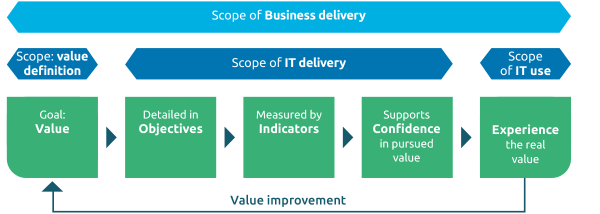Today's organizations expect that their IT systems will enable them to generate business value. This business value may be financial but can just as well be a value in any other quantitative or qualitative way. To be able to specify the pursued value, people in the organization will detail their objectives. These objectives must be measurable to some extent. Therefore, indicators define a way to gain insight into specific objectives. Measuring these indicators is done by testing and other quality and value measuring activities. This testing results in information based on which the people involved can form an opinion and determine to what extent they are confident that the pursued value can be achieved. After the decision has been made to use the IT system, the organization can experience the real value. This experience will be used to further improve the value in the organization.
DefinitionThe VOICE model is about establishing the level of confidence that the pursued business value can be achieved. It consists of 5 terms: Value, Objectives, Indicators, Confidence and Experience. |

This is visualized in the VOICE model. This is a generic model, relevant for all kinds of IT delivery lifecycles that support business delivery. VOICE is an acronym of Value, Objectives, Indicators, Confidence and Experience, terms that together describe how to implement delivery of business value.
High-performance IT delivery teams (such as in DevOps) also use the VOICE model as a foundation to structure and organize their work. In these teams one of the many task-groups is quality engineering. This book will support you in organizing and performing the quality engineering tasks within your high-performance IT delivery team, irrespective of whether you see yourself as a developer, an operations person, a business analyst, a systems architect, a tester, a product owner, a coach, a manager or whatever other role or function. We strongly believe that high-performance IT delivery teams have capabilities as a team, the capabilities of the people in the team contribute to the team as a whole, and tasks can be performed by various team members. One team member may be more skilled than another, but that is no reason to only provide work to the team member with most experience and skills. Think of all tasks as a team effort in which each team member plays a role. And keep in mind that teams have team skills, and team members have personal and interpersonal skills (read more about skills in this part).
Explanation of the VOICE model
The VOICE model for quality in IT consists of five terms
- Value: Any IT system aims to bring value to someone. This value must be defined, this often reveals implicit expectations and makes them explicit. Keep in mind that high quality alone is not always high value. Quality means different things to different (groups of) people. Sometimes there is more value in a system with a lower quality level that is quickly available than in a high-quality system that is available too late.
- Objectives: To understand the purpose of an IT system and how to create and maintain it, there must be quantifiable objectives with an adequate level of detail.
- Indicators: Whether the objectives are met, and whether the pursued value can be achieved, needs to be measured. To this end, indicators are specified that will be measured by testing and other quality measuring activities.
- Confidence: The result of measuring the indicators will be good information for stakeholders to gain confidence that the IT system will be able to achieve the pursued value.
- Experience: After the IT system has been incorporated in the operational business processes, the people in the organization will experience the actual business value. Based on this, they may define further improvements and a new cycle of the VOICE model is triggered.
The duration and speed of the cycles of the VOICE model significantly differ depending on the IT delivery model that is used and the release cycles in such a model. In sequential IT delivery (such as waterfall or V model) the cycles may be months, whereas in high-performance IT delivery (such as Scrum or DevOps) the cycles will be weeks or days or even minutes.
Implementation remarks on the VOICE model
The VOICE model does not describe all IT activities. These will be defined in the specific IT delivery model that the team(s) use(s). We use the VOICE model as an overarching model. The IT delivery models are grouped as sequential, high-performance and hybrid.
Value in this context refers to achieving the business case (or a lower-level result such as a change-request), but also to reach it in an efficient and effective way. Translating value to objectives may be a very simple task when the scope is a very limited user story; on the other hand, it may be a huge effort when the value refers to creating a complete IT system.
The stakeholders will consist of a broad group of people, varying from business managers, end users and customers, to the business analysts, developers, testers and operations people, amongst many others. All stakeholders are involved in some way in defining the objectives and indicators. The team uses those objectives and indicators to determine which activities they need to perform at what point in time. Depending on the IT delivery model (such as DevOps or sequential or anything else) the team will plan their work and supply information to the stakeholders so that the stakeholders can establish their feeling of confidence that the pursued business value will be attainable.
Different parts of the VOICE model will be relevant to different roles. The table below shows a basic setup of which role is mainly involved in what parts of the VOICE model. This may need to be adjusted to suit the needs of your organization.
|
Role |
Value |
Objectives |
Indicators |
Confidence |
Experience |
|---|---|---|---|---|---|
|
Product owner |
X |
X |
|
X |
X |
|
Business analyst |
X |
X |
X |
|
|
|
Systems architect |
X |
X |
X |
|
|
|
Developer |
|
X |
X |
|
|
|
Tester |
|
X |
X |
X |
|
|
Operations |
|
|
X |
X |
X |
|
Agile coach |
|
X |
X |
X |
|
|
User |
X |
X |
|
|
X |
|
Customers |
|
|
|
|
X |
Examples of indicators in the VOICE model
The indicators in the VOICE model are the starting point for determining the needed testing activities, and other quality measuring activities. Of course, the objectives that the team must achieve, and which will be measured based on these indicators, can vary a lot. In the next section some ideas for creating and how to select your own indicators are given. Continue
The VOICE model applied to...
The VOICE model is about establishing the level of confidence that the pursued business value can be achieved. By taking the Value as a starting point, you ensure that the focus is on the goal of IT delivery, and the people involved keep being reminded that IT delivery itself is not the goal.
While the VOICE model concerns supplying information, the Delivery Models are about creating systems. The VOICE model therefore supports gathering information about IT systems during the time these systems are created and maintained.
Continuous quality assurance and testing are essential to supply vital feedback to all people involved and to promote achieving valuable systems.
How the VOICE model applies to DevOps; continue here.
Or continue to the various Delivery Models:
Continue to:
Introduction to QA & Testing Topics


